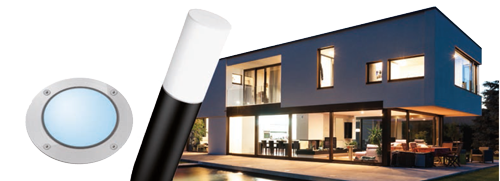Light Switch technology and regulation
If safety is the most important thing in a house, or an apartment, light is also an indispensable criterion for living comfortably. So to combine these two aspects necessary for the well-being of your "home sweet home", safety standards exist for the installation of your light switches.
Whether you are building your house or renovating your interior, these rules are not to be neglected to ensure the safety of all. If you look at a newly constructed house, you will notice that the house switches are placed at a certain distance from the ground and might be in similar positions in most rooms, for a very specific reason: to combine convenience and safety in your home.
Number of switches required, location standards, everything must be designed to make your life easier and safer!
How Many Light Switches Are Required in a Room?
The first thing you need to find out before you get started on wiring is how many light switches are required in a room. For many homes, the regulation is one light switch on one wall. It makes no sense to have two switches on the same wall operating one light fixture. If the room is large, you can have a second switch on the opposite wall.
However, there are special cases. In a bedroom, for example, a switch may be on each side of the bed so that a light can be turned on by two different people.

On the other hand, two switches may be on the same wall if they do not turn on the same light. In a kitchen, for example, we may find two different light switches: one to light the whole room, and the other to light the worktop. By the way, one thing to take into account is how many lights need to be installed to light a room. This can depend on various characteristics:
- The room's brightness: if the room is bright and shiny, one light fixture will be enough to light up the whole room. For darker rooms with less reflective walls, you might want to use more lights. Ensure that they are not too close to each other as they tend to throw unflattering shadows.
- Size of the room: the bigger the room, the more light fixtures you will need. You might have to choose whether you want one switch for all the lights in the room or different switches for them. For efficiency, it is recommended to have separate switches for the lights in the rooms.
- The effect you are going for: if you want the lights to have a different effect in a room, you might have to change the fixtures. Be careful when adding fixtures like chandeliers in the house. They might not be okay for a house with low roofs The number of lights chosen can then influence the number of switches to be provided for each room.
Indeed, in a large room such as a living room / dining room, several lights are to be provided but also several light switches depending on where you want to be able to illuminate this or that light.
How To Position the Light Switches in Your Home?
What Is the Standard Light Switch Height?
One of the most asked questions is what the light switch height from floor should be. The answer to this will vary greatly based on various reasons. However, one of the things you will need to remember is to have these lights at a safe distance away from children's reach. It is just a precautionary measure to prevent the children from getting into an accident or damaging the light switch. Various rooms in the house will have varying heights and instructions on where the light switch should be placed. The one thing that is, however, the standard for general house construction is to have the light switches at 48 to 52 inches above the floor. The main reason for this is, it is at a comfortable height for most standing people and a safe distance from the children. However, there are considerations made for light switch code height in a home that might have disabled people or a switch that needs to be above a countertop. Countertop switches need to be at least 4 inches above the countertop. At the end of the day, ensure you look at the house's functionality before you put a light switch in it. It will go a long way to protect you and the home from any issues.
To ensure you stay safe, various light switch location regulations are put out by the National elective code. What these regulations allow for is safety, especially when it comes to using the switches. These regulations apply to many areas in the house that deals with water or high heat. Adhering to these rules will help you stay safe even as you use the lighting fixtures in your home.
Bathroom Light Switch Height
The bathroom is one of the places where electrocution can happen easily. The bathroom light switch location is important since many people might soak in the bath or shower running, it might cause moisture to get to the sockets. The only way you can avoid this is if you have the sockets put in a safe place. To allow for this, it is recommended that you out light switches at least 5 feet from the tub or shower. This will prevent anyone from touching it with wet hands. The light switch near the shower code states that you need to keep these two at least 60 cm apart. The moisture from the showerhead might cause issues with the lighting in the bathroom.
Kitchen Light Switch Location
A good kitchen should be well lit. As such, you need to be keen on where you place your lighting fixtures and the switches. To ensure good visibility, place the switch to the main kitchen light at the doorway. Doing this ensures you can see in the kitchen without an issue. Depending on the number of workstations you have, you can choose to light them up. It is best if these areas have their separate switches. The preferred place for these switches is near the work stations. It will help you see what you are working on without straining.
Bed Light Switch Height
Outdoor Light Switch Code

If you have outdoor lights, you will need to figure or where you will place the switch. The best place to put this light is next to the door. You can easily access it there when you need to see the outside or need to switch off the lights. Ensure that the light on the outside is at a place where water cannot get to it. If you do not have a patio, then this would be the best tie to create one. If this is not possible, ensure the light itself is put in a way such that it stays waterproof. It will save you a lot of trouble in the long run.
Now you know all the tricks and standards when it comes to light switches. It is important to think about this when building your house or renovating your interior, so that you don't make any mistakes. The light of an interior is indispensable, and the tools to operate this light must be safely and conveniently accessible. The location and number of switches in each room must be thought out and considered in terms of safety, especially in bathrooms, but also in terms of comfort, in corridors or in a bedroom for example.
Once the location has been chosen, it is up to you to determine what type of switch you need depending on the room.
Another major thing that has been done in terms of technology is the introduction of smart light. This works well, especially if you are in a place where you might not be able to access the actual light switch. Some of these lights respond to voice commands or simply clapping your hands. Ensure you get a system that can integrate with other smart features that you might want to add to your house in the future.
Always have all your electric sources checked on regularly. It will help you spot any issues that may arise and have these fixed before they get worse.



